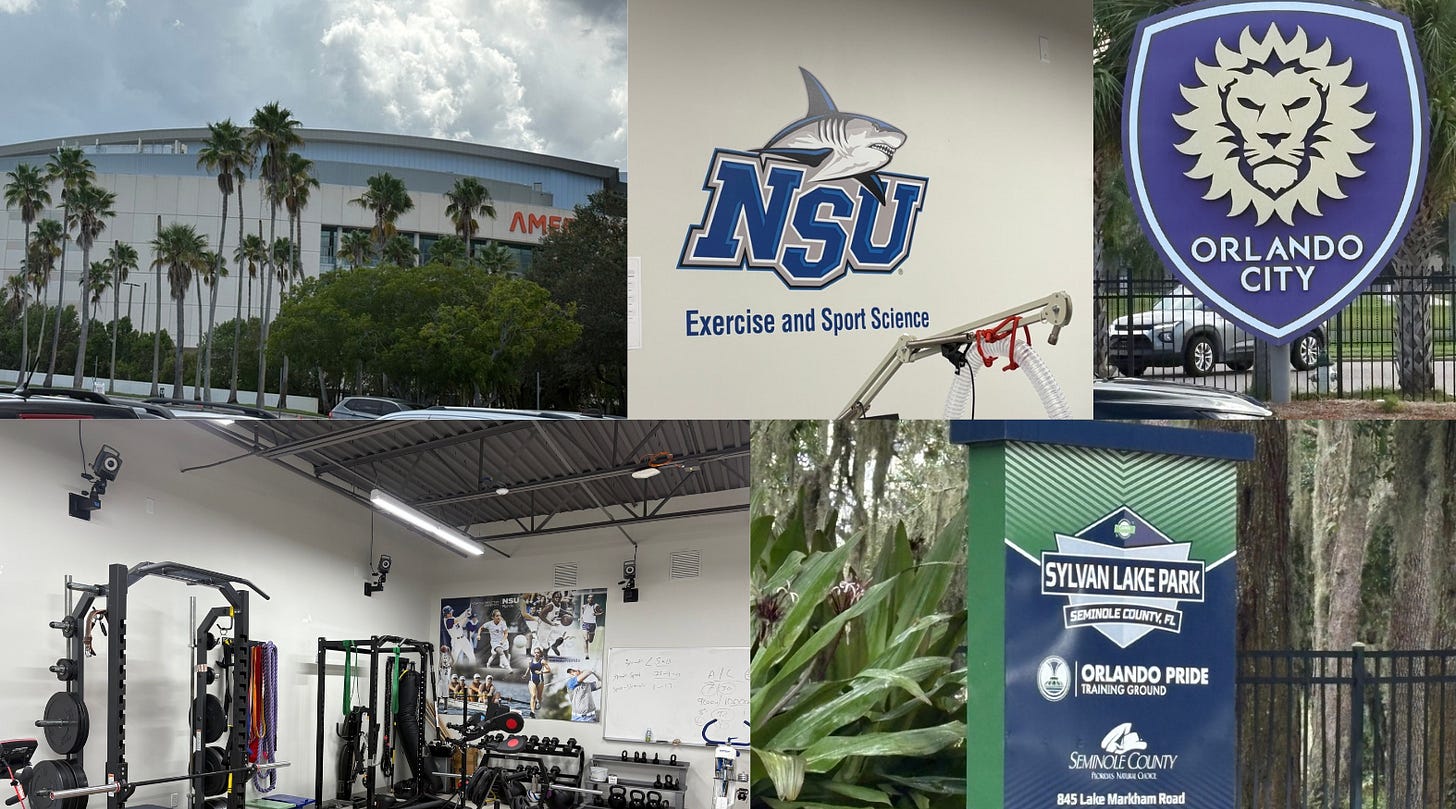✈️ Upside Special Report: Florida Trip: 9 Key Takeaways
I am now heading back to New York after spending a week in Florida (Miami, Orlando, Tampa) where I spent time with several teams (NHL, MLS, NWSL, NBA, MLB, NCAA..), top NBA/NFL/ATP practitioners, vendors, and the conversations reinforced just how quickly the technology landscape in elite sports is shifting. A few clear themes stood out:
1. Technology as a recruiting advantage
More teams are now framing technology not only as a performance and injury reduction tool but also as a recruiting edge. Players are increasingly attracted to environments that take their health and careers seriously. When a team can show it’s using cutting-edge tools to keep players healthy, extend careers, and maximize performance, it becomes a differentiator in the marketplace.
2. Portability is becoming a must-have
Teams are traveling more than ever, and performance routines need to follow them on the road. If a piece of technology isn’t portable, it risks being left behind. The demand is clear: solutions must be lightweight, easy to set up, and reliable in different environments, whether in training facilities, hotels, or stadiums.
3. Workflow integration is non-negotiable
Time with athletes is precious. Any technology that disrupts established workflows — especially if it takes away from breaks, refueling windows, or recovery time — is quickly sidelined. Teams are asking: How seamlessly does this tool fit into our daily rhythm? If it adds friction, it won’t make the cut.
4. Feedback-driven partnerships
One of the strongest signals from teams is that they want to work with vendors who actually listen. If a startup can’t adapt or improve based on practitioner feedback, the relationship ends quickly. Technology in elite sports is not “plug and play” — it’s collaborative. Vendors that co-develop with teams are the ones earning trust.
5. Teams want flexibility
Another point that kept coming up: teams don’t want to buy everything from a single vendor. They want flexibility to choose best-in-class solutions in different categories and integrate them into their own ecosystem. Lock-in strategies might work in other industries, but in elite sports, they backfire. Teams prefer modular solutions that let them mix, match, and adapt as their needs evolve.
6. The rise of “tech graveyards”
I saw more evidence of what some practitioners call “tech graveyards” — shelves or storage rooms full of devices that were once hyped but now sit unused. The reasons vary: lack of adoption, workflow disruption, or limited ROI. With tech audits becoming more common, teams are cutting ruthlessly. Only the solutions that deliver clear, measurable value will survive.
7. Recovery is a major focus area
Teams are increasingly interested in recovery modalities like red light therapy, shockwave, and laser therapy. Recovery is now seen as a core performance pillar, not just a supporting process. The arms race isn’t just about who can train harder — it’s about who can recover smarter and faster.
8. Scientific validation is a competitive advantage
The bar is rising for startups. Teams are tired of hype and marketing claims. What matters is peer-reviewed research, pilot studies, and validation. Startups that bring strong data and science to back up their tech stand out immediately. In some cases, having published evidence is the deciding factor in adoption.
9. Growing interest towards blood analysis and cognitive assessment tools
Another key trend that I saw catching up with teams is around the area of blood analysis and cognitive assessment. Why? Blood analysis allows teams to see if athletes are overtraining, under-training or about to get sick. It also helps teams optimize athletes’ performance. There is also growing interest for cognitive assessment solutions. Why? Teams are now using those tools to help athletes performance better while being fatigue. It helps athletes become more resilient. Now vendors with solid studies to back up their claims are the ones gaining traction.
The bigger picture
What’s clear from all of this is that teams are becoming more sophisticated buyers of technology. They are asking tougher questions, demanding portability, rejecting anything that disrupts routines, avoiding vendor lock-in, and gravitating toward solutions backed by science.
For startups and vendors, the message is simple:
Make it easy to use and travel with.
Ensure it fits naturally into workflows.
Be open to feedback and adapt quickly.
Avoid lock-in, give teams flexibility.
Back everything with science and data.
The teams that master this balance of innovation and practicality will be the ones that consistently find competitive advantages — both on the field and in attracting top talent. We will be back soon in Florida for our MIami summit., We hope to see all of you at our 2025 Upside US Summit on October 21 taken place at a world’s class stadium. We expect 300 attendees, top teams (NBA, NFL, MLS, MLB, NHL, NCAA, NWSL, WNBA..) , 10 panel discussions, 2 keynotes, 30 exhibitors, 15+ VCs and family offices, and a 1 hour speed dating session with top teams. You don’t want to miss it! You can get your ticket here. We have 6 booths left so if you want to exhibit, sponsor and even speak at our summit, you can also email at julien@upsideglobal.co
Best,
You may also like:



